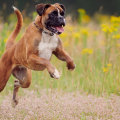Although each variety has a slightly different appearance in terms of coloration, all hamsters have similar physical characteristics and sensory abilities. The following general statements can be made across all types:
- Dwarf hamsters are less than 5 inches / 12.7 cm in length.
- Their overall physical conformation is “ball” like.
- They have short tails.
- Their ears are small and curved.
- They have cheek pouches for storing food.
- Their double coat is of medium length.
- The muzzle is short with a small nose.
- The eyes are large and may range in color from black to red.
Again, depending on species, coat colors range from white, through shades of light brown and gray, to black.
Hamsters are born blind and even as adults can only see a few inches in front of their noses. As pets, they are often injured from falls because they cannot see far enough ahead of their body to anticipate and avoid the danger. For this reason, multi-level cages are not recommended.
It’s dangerous to let a hamster ride on your shoulder or to hold him from a standing height. A fall or a leap could lead in broken bones, internal injuries, and even death.
Hamsters do, however, have truly exceptional hearing, communicating with one another at frequencies humans cannot detect.
You may see your hamster freeze at an unusual sound. He will then put his nose in the air, seeking additional information.
Speak softly to your hamsters and keep him in a quiet part of your home away from loud, sudden noises that will frighten your pet and cause him extreme stress.
This includes loud, squealing children and even an incessantly barking dog. You certainly don’t want to put your hamster’s cage next to the TV set or the stereo!
A hamster’s sense of smell is equally acute. These tiny creatures use their noses to distinguish gender, locate food, and navigate social situations through behaviors like territorial marking.
Always wash your hands before and after handling your hamsters. If you transfer an unusual odor from your hands to your pet, the hamster may become unduly agitated. Washing your hands after handling your pet also helps to prevent the spread of disease.






 Author and long-time animal lover. Sharing knowledge on pet care through experience and the written word.
Author and long-time animal lover. Sharing knowledge on pet care through experience and the written word.